Fri 19 Jun 2009
Movie Review: SWAMP WATER (1941).
Posted by Steve under Crime Fiction IV , Films: Drama/Romance , Reviews[17] Comments
SWAMP WATER. 20th Century-Fox, 1941. Walter Brennan, Walter Huston, Anne Baxter, Dana Andrews, Virginia Gilmore, John Carradine, Mary Howard, Eugene Pallette, Ward Bond, Guinn Williams. Based on the novel by Vereen Bell. Director: Jean Renoir.
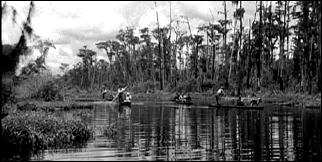
From what I’ve learned recently that I didn’t know about director Jean Renoir before I sat down to write up some thoughts about this movie, his first American film, Orson Welles considered him the greatest director of all time, and he was voted the 12th-greatest director of all time in a poll conducted by Entertainment Weekly magazine.
I think I could easily go along with Orson Welles. Even though the critics don’t seem to have thought too highly of Swamp Water, the general public did, and it was one of Fox’s highest grossing films of 1941. I agree. The general public was right this time.
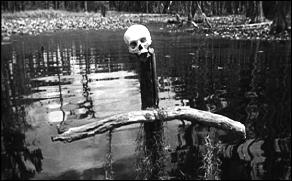
There is a lot to like in this film, even though it doesn’t seem to be regarded even now as one of Renoir’s best, and while I haven’t done so yet, I think that it will bear one or more viewings by me, very easily.
That the atmosphere of a small Georgian community on the edge of the huge Okefenokee Swamp is portrayed in a highly realistic fashion almost goes without saying — or maybe it doesn’t, so I will.
It’s not clear how someone having come to this country straight from Europe could have visualized and reproduced life in a small Southern town so well that it feels like everyone in the movie had lived there all their life — but that’s the feeling I received, only slightly cliched in (unfortunately) standard Hollywood fashion.
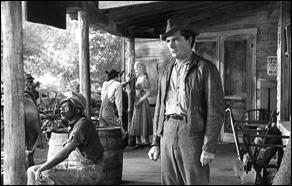
Of course it helps that a good portion of the movie was filmed on location. The only serious omission, I think, is that I do not remember seeing any blacks in the film, only whites, and yet even so, the idea that not all men were created equal in the US in the 1940s still manages to make itself felt, if even only subtly.
And it is a crime film, although when it comes to movies, as you will have seen on this blog, I’ve been insisting on that less and less as time has gone on. You could even call it “swamp noir.” The mood is dark enough at times, as life seems to go wrong at every turn for trapper Ben Ragan (Dana Andrews) after he stumbles across fugitive from justice Tom Keefer (Walter Brennan) hiding in the swamp while hunting for his lost dog Trouble.
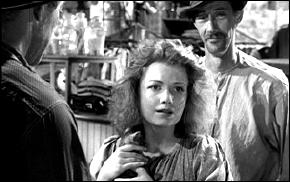
Agreeing not to turn Keefer in, Ben returns home and tries to keep Keefer’s secret from everyone but the latter’s daughter, the wild-haired Julie (Anne Baxter), who’s treated as little more than a scullery maid by the family who has taken her in, but with little success, no thanks to his jealous girl friend Mabel MacKenzie (Virginia Gilmore), blonde and far more perfectly coiffed.
Ben is also on the outs with his father Thursday (Walter Huston), who second marriage to Miss Hannah (Mary Howard) is beginning to falter, thanks to the attention being paid to her when Thursday is gone by the pathetic and largely contemptible Jesse Wick (John Carradine).
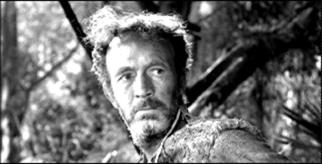
There’s a lot more to the story, with all of the pieces dovetailing nicely, and all of the players fitting their parts to a T, especially (and this came as a surprise to me) Walter Brennan, whom I usually think of as overacting greatly, but not in this role. As a speaker of soliloquies to the stars and to nature in general, his presence on the screen I found to be as mesmerizing as any I can recall in quite a while.
Not that he was on screen a high percentage of the time. The honor in that regard goes to Dana Andrews, whose Southern accent was the most pronounced, but which started to sound more and more natural as the movie went on. As did the movie itself.
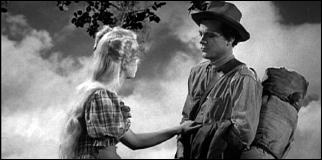
Flawed by more of a sentimental ending than I expected, perhaps, and also because (and this is another perhaps) Renoir had the movie selected for him rather than the other way around, this is a movie that I enjoyed immensely. If you have a chance to see it, given that you’ve read this review all the way here to the end, I recommend it to you highly.
[UPDATE] 6-20-09. First an email note from Bill Crider, who says, “You know my fondness for this kind of book means that I own a copy.” And here it is, or the cover, at least, thanks to Bill:
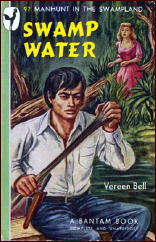
Bantam 97, June 1947. (Originally Little Brown, hardcover, 1941.)
Then another note, this one from Al Hubin, who agrees that the book belongs in the Revised Crime Fiction IV, not previously incuded. He also points out the existence of the second filmed version, Lure of the Wilderness, 1952, with Jean Peters and Jeffrey Hunter, and directed by Jean Negulesco.
June 19th, 2009 at 11:36 pm
I’ve always thought it ironic that both Renoir and Fritz Lang’s first American films (Fury) were about miscarriages of justice and men who have to deal with that. I agree this is a superior film, and better than the critics opinion of it. Still, it must have come as a shock to critics expecting something along the lines of The Rules of the Game. That’s likely the cause of the reviews.
The book by Vernon Bell is a good read, and worth looking up.
It was remade as Lure of the Wilderness by another French refugee Jean Negluesco in 1952 with Jeffrey Hunter, Jean Peters, and again, Walter Brennan. Not as good as the Renoir version, but not bad, and certainly nice to look at in color.
As for Brennan’s overacting it was often as not the result of playing opposite so many noted under actors like Gary Cooper and John Wayne. In any case he won two Oscars in the period that Swamp Water was made in well before he became something of a parody of himself in later films.
Back when the Cowboy Hall of Fame opened here in Oklahoma City a number of famous western stars came for the celebration. A friend of mine was in attendance and hoping to get autographs of some of his favorites. He was in the lobby of one of the cities better hotels with another friend when he saw two elderly men leaving the elevators.
“Look,” he told his friend excitedly, “Joel McCrea, I’m going to get his autograph.”
And true to his word he went over, excused himself, and asked McCrea for his autograph, but he admitted the whole time that both elderly men looked at him rather oddly.
When he went back to his friend he was still excited.
“Imagine,” he said, “just standing here and I got Joel McCrea’s autograph.”
“Yeah,” his friend said, “and Walter Brennan too.”
Of course I don’t swear to the validity of the story, but if it didn’t happen, it should have.
June 20th, 2009 at 1:00 am
Since writing this review, I found the one that appeared in the New York Times
http://movies.nytimes.com/movie/review?res=9903EFD8163AE233A25754C1A9679D946093D6CF
Here’s the first paragraph:
“The fact that Jean Renoir’s initial screen exercise in this country was completed before he learned the A B C’s of our language will mitigate somewhat his responsibility for SWAMP WATER, now at the Globe. Unfortunately, no one else has nearly as good an excuse for this melodramatic mess about Georgia crackers. Dudley Nichols, who has done a stunning script or two in his time is guilty of as fraudulent a scenario as the year has seen, and under the circumstances the performances of such capable folk as Walter Huston, Walter Brennan, John Carradine, Dana Andrews and Anne Baxter are perilously close to silly. Some first-rate talents have disappeared over their ears in SWAMP WATER.”
I guess that tells you what the New York crowd thought about Georgia crackers.
David —
Funny you should happen to mention Joel McCrea. He’s one of the two lead stars in the movie I’ll be writing up next, along with Jean Arthur.
June 20th, 2009 at 6:50 pm
Jean Renoir is a superb director.
In France, Renoir had made a good film about rural life, TONI (1934). Perhaps that helped him understand Georgia.
Renoir went on to make a film noir WOMAN ON THE BEACH (1947). I like it – but hardly anyone else does!
SWAMP WATER represents Renoir, on my list of outstanding American feature films:
http://mikegrost.com/zlist.htm
June 20th, 2009 at 8:38 pm
Woman on the Beach isn’t Renoir’s best effort, but it is better than its reputation, and Robert Ryan is very good in it, as is Charles Bickford. The scene with the blind Bickford on the cliff side is memorable. I think this was Renoir’s last American film. I like it much better than its reputation and consider it at worst a near miss.
Anyone interested in Hollywood in this period should check out Otto Friedrich’s City of Nets: A Portrait of Hollywood in the 1940’s. It deals with everything from the influx of refugees to the blacklist and those infamous water rights that featured in Chinatown.
Though Friedrich says little about Renoir, he does mention that when Renoir came to Hollywood he brought Antoine de St. Exupéry with him, author of, among other things, The Little Prince.
June 20th, 2009 at 9:02 pm
Mike
That’s quite a list you put together on your website. I don’t think I ever saw it before, though I’ve spent a lot of time on your site. It’s really an eclectic mixture of all kinds of movies.
In fact it includes Run a Crooked Mile, a made-for-TV movie that’s also a favorite of David’s. I just posted his comments on it no more than an hour ago.
David suggests that a reason contemporaneous critics panned SWAMP WATER so badly (see the NY Times review above as an example) is that they were expecting another THE RULES OF THE GAME, and they didn’t get it.
My opinion (so far) is that metropolitan-type reviewers simply didn’t understand what life was like in the rest of the country.
Any thoughts on this yourself?
— Steve
June 20th, 2009 at 9:35 pm
Steve,
Don’t know why US reviewers panned SWAMP WATER. When the French finally got to see it and other US Renoir films after WWII, they were disappointed Renoir’s American movies didn’t resemble his French ones, such as RULES OF THE GAME.
However, it is unclear what US reviewers thought of Renoir. Renoir’s GRAND ILLUSION was extremely prestigious here in the USA. President Roosevelt said it was a film that everyone who loved democracy should see. That’s what one calls an endoresement!
The Vereen Bell article you linked to said that SWAMP WATER was a huge hit in the US South. Apparently Sourtherners were bursting with pride at seeing the Okefenokee on screen, treated as a natural wonder.
Thank you for the kind words about my list. It was developed several years ago, as an alternative to the universally reviled and just plain awful AFI list of top movies. My list tries to show the real diversity and accomplishment of American Film.
June 21st, 2009 at 4:35 pm
You almost always get a more interesting view of the best films from someone like Mike who has watched and thought about what he likes than from critics or the AFI. Critics lean too heavily toward trying to impress us with their choices (Raging Bull was a fine movie, but I’ll be content if I never have to sit through it again) and the AFI always scraps great older films for more recent works that may or may not stand the test of time.
Someone like Mike who is sincerely talking about films he liked, and not trying to impress anyone is likely to produce a far more representative and honest list of films.
I can recognize a film as a masterpiece,and still not list it as a favorite because for some reason it doesn’t appeal to me. I’d rather read an honest and thoughtful list like Mike’s than one that is trying to impress fellow critics and posterity or catering to audiences that haven’t seen anything older than the 1980’s.
And I’ve found as I mature the books and films that entertained me count much more than the “great” ones. It’s nice when the two are the same, but I’ve discovered I no longer care if posterity agrees with me if I enjoyed it.
Maybe I have just banked the fires of that youthful passion to convert others to my point of view. Nowadays whenever I feel the evangelistic urge I keep thinking of that line of James Joyce: “Are you trying to convert me, or pervert yourself?”
June 21st, 2009 at 4:56 pm
Steve
Forgot to mention it, but re your question about the critics and the rural setting I would have to point out that both The Grapes of Wrath and Tobacco Road (both John Ford) were critically praised in roughly this same period (Road even starred Swamp Water lead Dana Andrews).
I suspect critics were expecting a sharply observed social drama/comedy along the line of Rules of the Game or class comment/ social drama like Grand Illusion, in short for French director Renoir to make a French film, not an American one. Fritz Lang had some of the same problems about his first American film Fury.
If you look back you’ll see quite a few films we now consider masterpieces got cool critical receptions on release and may not have done that well at the box office. It’s a Wonderful Life was such a flop James Stewart had to go to Broadway and do Harvey to revive his career.
I suspect the critics wanted Renoir to go a Rules of the Game or Grand Illusion while Renoir wanted to do something American, and they punished him for daring to challenge their expectations and preconceptions. I’m willing to bet the same film from an American director would have been hailed as a native American classic by the same critics who panned the film from Renoir.
Even big stars ran into this when they dared to challenge what the audience and critics expected. Clark Gable in Parnell, Cary Grant in None But the Lonely Heart, and Gary Cooper in Along Came Jones all learned it didn’t matter how good they were if they didn’t give the audience and the critics what they expected.
November 14th, 2009 at 2:51 pm
I am trying to find out which actor was swallowed up by quicksand in this movie. Does anyone know?
November 19th, 2009 at 12:13 pm
I asked David Vineyard, who replied almost immediately (and of course it all came back to me as soon as he did) —
It’s Guinn “Big Boy” Williams who goes down for the count in the quicksand in that famous scene.
January 2nd, 2010 at 11:02 am
Part of the reason the ending may seem flawed is that it is not the originalas Renoir intended. Apparently Zanuck, the producer/studio head, rewrote the ending himself and had it directed by a contract hack.
January 14th, 2011 at 11:55 am
I saw Lure of the Wilderness, a remake of the Swamp Water story, in Savannah, Georgia. I grew up outside that city on the edge of a swamp. Later when I saw the original by Jean Renoir at Harvard I realized my mother was right. The original in B&W by Renoir was the best. Renoir got the people right, even the minor characters. Just as he did in his European films–and as his father did in his paintings. I heard Renoir talk about his career on a visit to Harvard. He said his mother dropped him off in a daycare room at a French supermarket where they showed films, the start of his love of cinema. I love that film because it is the only view of the south that got the atmosphere and people right without stereotype. Perhaps it took a brilliant outsider of the US to do it.
December 13th, 2011 at 3:21 am
Just saw this tonight (on a double-bill with Frank Borzage’s Moonrise) at the Roxie in San Francisco, and was absolutely wowed. Your review is pretty spot-on. Walter Brennan is absolutely a stand-out. I love how both this film and Woman on the Beach (the only other American-period Renoir I’ve seen) both involve a kind-of “witch trial” sequence in which a character has to risk his life in order to prove his trustworthiness.
Fascinating to learn that the film was a hit in the South. Must find out if the same applies to Moonrise.
On the question of critics’ expectations, I wonder how many critics had even seen The Rules of the Game prior to 1941. Of course Grand Illusion was well-known, and perhaps some of Renoir’s other 1930s work as well. But I’m under the impression that The Rules of the Game wasn’t really properly distributed in the United States until 1950. And since this was before film festivals had made it to US shores, I’m not sure how critics would have had a chance to see an undistributed film.
Anyway, this was my thirteenth Renoir film seen, and it was certainly not an unlucky screening. Will have to check out your other blog posts now!
April 10th, 2012 at 2:22 pm
This is now in release on Blu Ray from Twilight Time: http://www.screenarchives.com/title_detail.cfm/ID/16941/SWAMP-WATER-1941/
April 10th, 2012 at 2:34 pm
Thanks, Ryan. My copy was taped from TCM or some other source, so maybe it’s worth getting one in decent shape.
February 13th, 2013 at 12:41 am
14. Thanks Ryan. Just ordered it.
I saw this movie about 1957 (age 11) & thought it was great. I am from Raybon Community which is 20 miles E of the Waycross entrance to the Okefenokee. When I read some of the dialogue on IMDB(?), it was somewhat peculiar. Wonder if it was taken directly from the book. Otherwise, it was very realistic. I recall that 4 movies were made in the swamp about that time.
April 30th, 2013 at 7:19 am
Guinn Williams got swallowed with quicksand